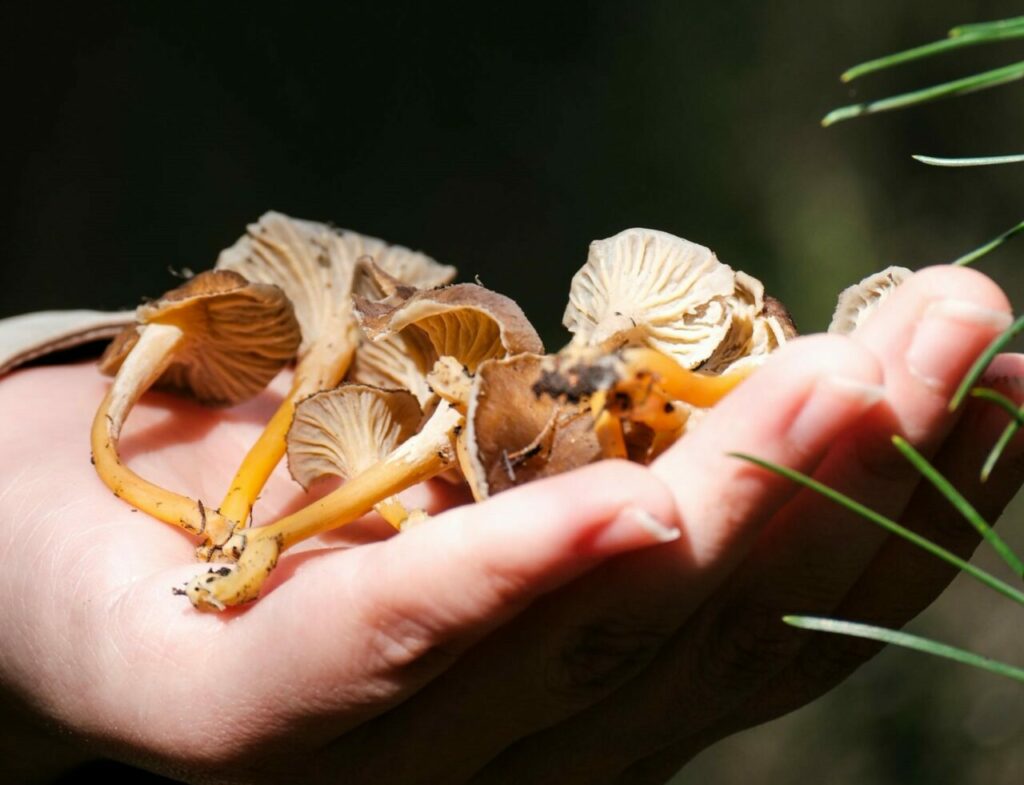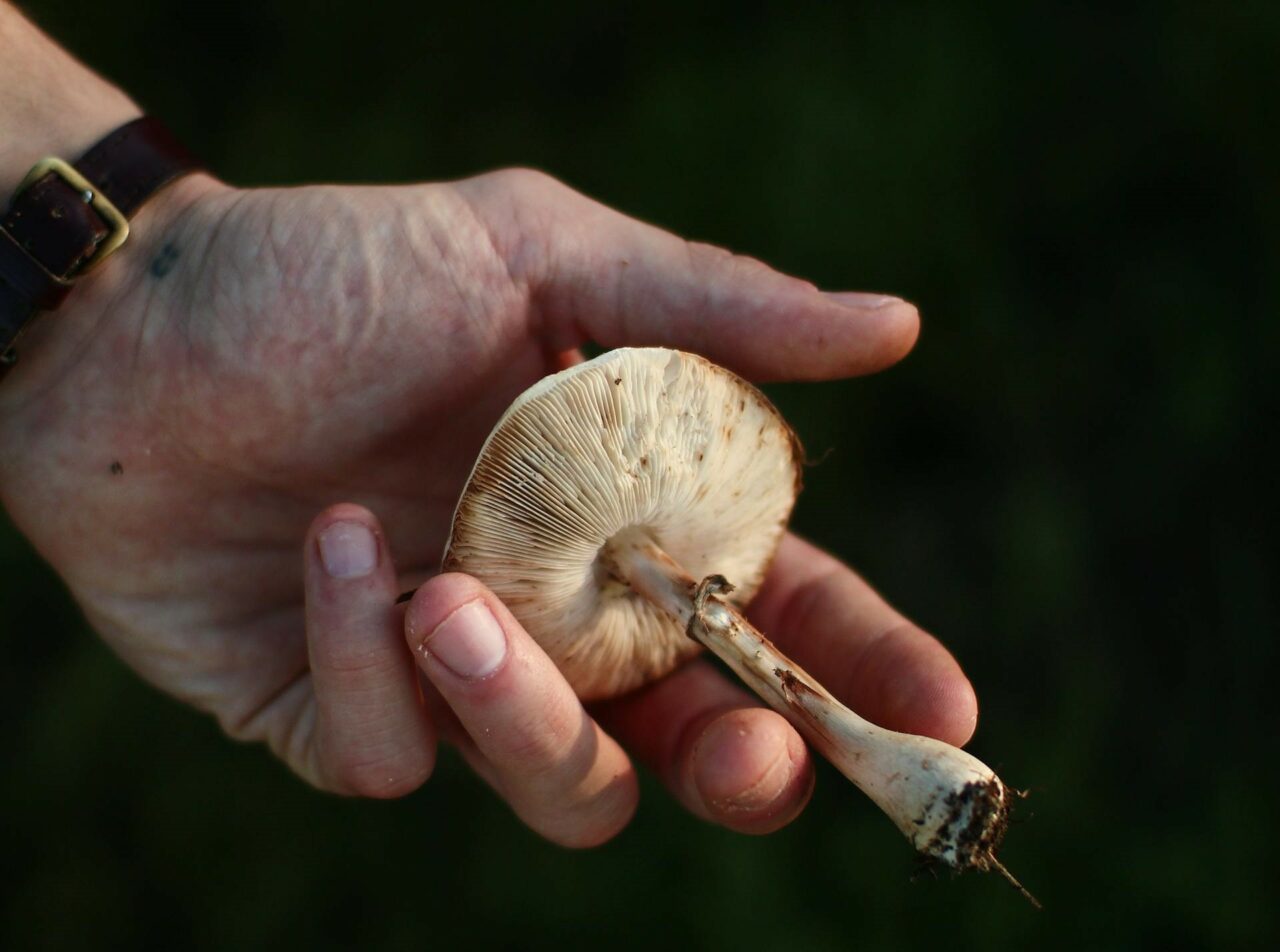Psilocybin mushrooms, like LSD, function as a traditional psychedelic by acting as a serotonin 5-HT2A receptor agonist. They are presently under research for use in psilocybin-assisted therapy for various mental health disorders such as severe depression, anxiety, cluster headaches, and migraines.
Understanding how shrooms can benefit these conditions requires insight into how they are metabolized in the body. This knowledge allows scientists and users to comprehend how the active compound manifests its psychological and therapeutic effects. This article offers a basic overview of the pharmacology and pharmacokinetics of psilocybin.
[toc]
Key Takeaways:
- When psychedelic fungi are consumed orally, half of it is absorbed and dispersed throughout the body.
- The fungi component undergoes dephosphorylation primarily in the liver, facilitated by the enzyme alkaline phosphatase.
- Around 3.4% of the compound is expelled in its initial form within a day, while the majority is excreted as a stable metabolite.
What Does Pharmacokinetics Mean?
Pharmacokinetics (PK) is the field that studies how substances such as drugs are processed by the body once they are introduced into the system. While it is related to pharmacodynamics – the study of how a compound interacts with the body – PK focuses on four primary areas: absorption, distribution, metabolism, and excretion (ADME).
Knowledge of these processes enables medical professionals to prescribe the most effective medications with minimal risk. It also allows them to customize treatments to suit each patient’s unique physiological and lifestyle needs.
How Does Pharmacokinetics Relate to Psilocybin?
Considerable interest has been shown in psilocybin and psilocin, the primary active compounds in certain types of magic mushrooms, by both researchers and users. Pharmacokinetics studies how the body metabolizes mushrooms containing psilocybin, providing insight into their potential medicinal or recreational effects.
These compounds, often referred to as “magic,” “psychedelic,” “medicinal,” or “sacred,” are found in fungi that are ingested. The Mushroom species, their places of origin, dimensions, growing and drying conditions, as well as their age, may result in significant changes in their potency levels.
Even though these mushrooms naturally grow in the wild, scientists have found ways to produce them synthetically. Both the natural and lab-created versions are relatively non-toxic, but minor side effects like nausea and vomiting can occur.
In spite of these physical effects, the compounds inside these mushrooms have demonstrated potential therapeutic uses due to their safe profile and non-addictive properties. This has sparked interest among researchers to explore their use in psychotherapy, particularly for treating anxiety and depression.
Understanding the 4 Stages of Pharmacokinetics
The compound psilocybin, present in these mushrooms, is inactive in its original state and acts as a prodrug. It transforms into its active form, psilocin, with the help of enzymes such as alkaline phosphatase. This conversion allows psilocin to be absorbed and distributed throughout the body, reaching various tissues. Nonetheless, after oral intake, psilocybin is not detectable in the circulatory system, feces, or urine.
Absorption
Absorption refers to the process by which the compound enters the bloodstream from the point of administration. It plays a crucial role in determining the speed and effectiveness of the compound reaching its target, such as the plasma. The most common method of administration is oral, although inhalation has been explored but is not as efficient.
The absorption process also includes the release of the compound from the dosage form during oral ingestion. Aspects such as delays in the throat or esophagus can affect this, potentially slowing down the effects or causing discomfort. Upon reaching the stomach, the acidic environment might start to degrade the compound before it enters the bloodstream.
Research on animals suggests that only around 50% of orally administered psychedelics are absorbed and distributed in the body.
Factors that Influence the Absorption Process
Various factors can influence the absorption process, leading to differences in the onset, intensity, and duration of the effects:
- Stomach Contents: Having a full stomach can slow down the process, delaying the onset of effects. Conversely, an empty stomach can facilitate quicker absorption.
- Phase I (CYP450 Reactions): This phase involves the oxidation of hallucinogenic substances into polar metabolites.
- Phase II (UGT Reactions): In this phase, the metabolites are conjugated to help distribute them throughout the body.
- The drug is deactivated in these steps and prepared for elimination through urine or bile.
- Body Fat: Substances may accumulate in fat tissues, potentially prolonging their effects.
- Age: Metabolic rates and body composition can change as a person ages.
- Zero-Order Kinetics: The substance is removed at a steady rate, regardless of its concentration.
- First-Order Kinetics: The rate of removal is proportional to the concentration of the drug.
The psilocybin molecule possesses a phosphate group that has high polarity. This property, combined with the positive charge of the amine group, gives the molecule a zwitterionic nature, increasing its solubility in water compared to psilocin. Without the phosphate group, psilocin becomes more lipid-soluble, more metabolically available, and is absorbed more readily in the intestines.
Understanding Metabolism
Metabolism refers to the way the body transforms mushroom strains into compounds that can be easily eliminated. This process involves enhancing the water solubility of the mushroom to allow for effective kidney clearance and is essential for activating the effects of the mushroom.
The liver primarily performs metabolism in two stages:
Distribution refers to how psilocin is dispersed within the body once it enters the bloodstream. Psilocin, being lipophilic, can traverse the blood-brain barrier to reach the central nervous system.
Various factors such as the product’s size, polarity, and protein-binding capacity, as well as individual physiological factors like hydration status and body composition, significantly affect the distribution process.
The goal is to achieve an effective concentration at the target area. For the product to work, it needs to arrive at the intended area, as defined by the distribution volume. It must remain unbound to proteins to interact actively with its receptor.
What Factors Affect the Distribution Process?
Numerous factors can influence the distribution process:
Typically, the effects begin to manifest between 20-40 minutes after ingestion, reaching a peak around 80-100 minutes. The effects of magic mushrooms generally last for about 4-6 hours.
How Does Distribution to the Brain Happen?
An initial experimental study on two species showed that its binding affinity order is 5HT2A > 5HT1A > 5HT2B [23]. It also binds to dopamine D1, 5HT1E, 5HT5A, 5HT7, 5HT6, D3, 5HT2C, and 5HT1B receptors.
Psilocin acts as a partial agonist at the 5HT2A receptor, with approximately 40% efficacy. The psychedelic effects are likely due to its partial agonist activity at 5HT1A autoreceptors.
The mood-enhancing and psychotomimetic experiences may be related to the observed correlation between increased dopamine levels and sensations of depersonalization and euphoria. Hallucinogens work by modifying neurochemistry and receptor activity. They amplify 5HT2A agonist activity by boosting BDNF synthesis in the hippocampus, which promotes neurogenesis and reduces conditioned fear-related behaviors.
Excretion
Excretion denotes the process where the The body expels substances primarily via the kidneys, and also through the lungs, skin, and digestive tract. When it comes to the kidneys, they filter or secrete natural psychedelic drugs in the glomerulus or tubules, with some reabsorption adding layers of complexity to the process.
The main substance has a half-life of roughly 160 minutes, whereas psilocin’s half-life is approximately 50 minutes. Animal studies indicate that most of it is excreted in the urine, accounting for about 65% within 8 hours. Even after consumption, small amounts of the substance can still be detected in the bile and feces.
In humans, about 3.4% of the substance is excreted in its original form within 24 hours, while most is eliminated as psilocin-O-glucuronide, a more stable metabolite. The stability of this compound allows it to be detected in urine for a longer duration.
There are two main ways that substances are expelled:
Most psychedelic drugs follow the first-order kinetics method, reaching stable concentrations after four to five half-lives. Full removal also occurs after four to five half-lives.
Discover Our Range of Hallucinogenic Mushrooms
The metabolic process differs among various types of fungi. When you buy from reliable online vendors like Get Magic Mushrooms Canada, you can avoid inadvertently consuming poisonous mushrooms. Some types, such as Agaric mushrooms, can cause intense and unpleasant reactions. Hence, it’s vital to obtain magic mushrooms from trusted dispensaries instead of uncertain street vendors or foraging in the wild.
| Feature | Enigma | Full Moon Party | Gold Member | |
| Strain Type | Psilocybe Cubensis OMNI | Psilocybe cubensis (Thai Koh Samui) | Psilocybe cubensis | |
| Potency | Exceptionally high; 3.8% tryptamine content | Moderate to high potency | High potency | |
| Visual Characteristics | Resembles a blob or | Resembles a cauliflower or brain in structure | Exhibits a conventional cubensis look, moderately sized | Characterized by thick white stems, golden caramel caps, and discernible blue bruising |
| Effects | Considered the most potent, generating intense effects | Offers a powerful mental high, with delayed onset featuring prominent visuals | Delivers potent visuals and a sense of euphoria |
Educate Yourself on Psilocybin Mushroom Usage Online
It is crucial for medical professionals, researchers, and users to understand the pharmacokinetics of shrooms. This understanding allows you to make well-informed decisions about dosage and timing, thus reducing potential risks.
Discover your perfect psychedelic experience at Get Magic Mushrooms Canada. Whether you’re in search of a tranquil journey or a deeper exploration, our wide selection of products is designed to meet your individual requirements. Enjoy top-quality, safe, and regulated shrooms, eliminating worries over unreliable sources or poisonous mushrooms.
Experience the best magic mushrooms Canada has to offer, and take your psychedelic adventure to unparalleled heights.
Frequently Asked Questions
Are there any known interactions between shrooms and other drugs?
Our products may interact with certain drugs, particularly those affecting serotonin levels, such as SSRIs (Selective Serotonin Reuptake Inhibitors). Both SSRIs and SNRIs (Serotonin and Norepinephrine Reuptake Inhibitors) tend to reduce the effects, unlike non-serotonergic antidepressants. This reduced effect could last up to three months after stopping the antidepressant.
Do all psychedelics activate the same way as psilocybin?
No, each psychedelic substance has a unique structure that requires different metabolic processes to become active, and they bind to varied receptors in the body. The method of administration also affects how each psychedelic is absorbed. While the basic principles of absorption, metabolism, and distribution remain consistent, the specific pathways and effects vary for each substance.
Does the form of the shroom affect the pharmacokinetics?
Yes, the form (whether fresh, powdered, or dried mushrooms) can influence the speed of absorption. For example, powdered forms might be absorbed faster than whole dried ones due to faster dissolution.
Related Articles:





